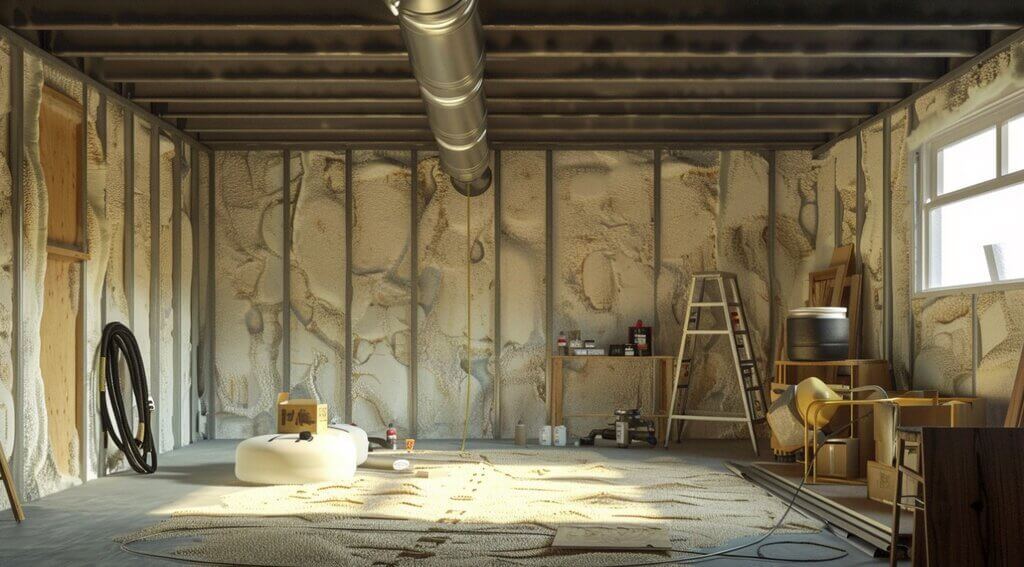Basement spray foam insulation stands as a key player in the realm of home improvement, offering a strategic method to fortify your basement against external elements.
This specialized insulation technique provides more than just a shield; it fosters an environment of enhanced energy efficiency and structural soundness.
Understanding the intricacies of basement spray foam application can unveil a world of benefits that extend far beyond mere insulation.
Let's explore how this innovation can redefine your basement's functionality and comfort.
Understanding Basement Spray Foam Insulation is crucial for homeowners looking to enhance energy efficiency and protect their living spaces from moisture infiltration and mold growth. =
Closed-cell spray foam insulation is the recommended choice for basement walls due to its high R-value and ability to create an airtight seal, reducing energy loss and improving overall energy efficiency.
By preventing moisture infiltration, spray foam insulation helps inhibit mold growth, leading to improved indoor air quality and a more comfortable living environment.
Proper preparation, moisture control, and application techniques are vital for a successful basement insulation project that can bring long-term value to the home.
Investing in basement spray foam insulation is a cost-effective approach to increasing energy savings, reducing drafts, and maintaining consistent indoor temperatures.
Spray foam insulation offers a range of significant benefits for basement walls, including superior air sealing capabilities and enhanced structural integrity.
By effectively sealing gaps and cracks, spray foam insulation prevents outside air, rodents, and insects from infiltrating the basement, contributing to a healthier indoor environment.
Moreover, its moisture-blocking properties reduce mold growth, ensuring a more comfortable living space.
The sturdiness of spray foam insulation enhances the structural integrity of the basement, providing long-lasting support. Its versatility caters to various needs, such as filling gaps and creating weather-resistant seals.
Additionally, spray foam insulation's non-settling and non-shrinking nature guarantees sustained energy efficiency, decreased drafts, and improved indoor air quality in the basement.
To ensure optimal conditions for the insulation process, it is imperative to thoroughly prepare your basement by addressing any existing structural or environmental concerns.
Before insulating, properly frame windows and doors to prevent air leakage, address any electrical issues, and eliminate mold growth. It is crucial to resolve water-related problems such as leaks or dampness in the basement before proceeding with insulation.
Ensuring a dry, clean, and well-prepared basement is essential to maximize the effectiveness of the spray foam insulation. By taking these preparatory steps, you create a suitable environment for the insulation application and contribute to the long-term success of the project.
Proper preparation sets the foundation for a well-insulated basement that enhances comfort, energy efficiency, and indoor air quality.
Before proceeding with the application of spray foam insulation in your basement, understanding the differences between high-pressure and low-pressure techniques is crucial for achieving optimal results in your insulation project.
When considering the application techniques for spray foam insulation, here are three key points to keep in mind:
Both high-pressure and low-pressure application methods ensure thorough coverage and strong adherence to surfaces, crucial for effective basement insulation.
One of the key considerations when evaluating basement spray foam insulation is its effectiveness in minimizing air leakage and enhancing energy efficiency.
Spray foam insulation seals gaps and penetrations, reducing drafts and heat loss, thus lowering energy consumption for heating and cooling.

Additionally, its airtight seal helps prevent moisture infiltration, reducing the risk of mold growth and improving indoor air quality.
Despite its higher initial cost compared to traditional insulation methods, the long-term energy savings and benefits of spray foam insulation make it a worthwhile investment for homeowners seeking improved comfort and reduced utility expenses.
Proper installation by trained professionals is essential to ensure optimal performance and durability of spray foam insulation in basements.
Considering the average cost range of $4,000 to $8,000, insulating a basement with spray foam encompasses the walls, ceiling, and rim joist, with factors such as basement size and insulation material choice influencing the total expenses.
When analyzing the cost of insulating your basement with spray foam, it's essential to consider:
Insulating basements poses unique challenges that traditional methods like fiberglass batts and poly air/vapor barriers struggle to address effectively, making spray foam insulation a superior choice for creating a protective barrier against moisture and mold growth.
Unlike conventional insulation, spray foam forms an air impermeable barrier that prevents dampness and mold, offering superior air sealing capabilities.
Traditional methods, such as framing walls and using plastic vapor barriers, may not provide adequate protection against moisture in basements, leading to potential issues like condensation and mold growth.
Spray foam insulation is recommended for basements due to its ability to mitigate these risks effectively, resulting in drier, more comfortable spaces with improved indoor air quality and energy efficiency.
When considering basement spray foam insulation, it is essential to be familiar with a selection of key products that are integral to the insulation process. Here are three essential spray foam insulation products:
These products play a vital role in ensuring proper insulation, moisture control, and energy efficiency in basement spaces. Selecting the right products for your project can make a significant difference in the overall effectiveness of the insulation.